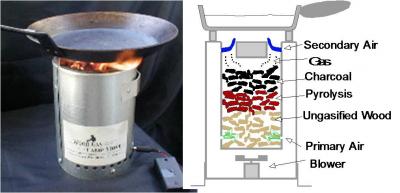I mounted some heavy duty casters on the base and drilled the air supply holes to the fire tube. The only thing that remains before firing the furnace is to install insulation in the combustion chamber. This is relatively easy.
Some good news is I've been offered a practically unlimited supply of small wood splits including a lot of eucalyptus. For those who don't know, this wood is extremely energy dense at well over 30 million BTU per cord (roughly twice as dense as untreated pine lumber) - and burns really hot! Some advise against burning it in traditional fireplaces due to the high oil content, but it's ideal for a gasification furnace.
I will try to describe the basic design. Consider the basic Top Lit Up Draft wood gasifier (called a TLUD):



If you understand how the TLUD works, then you will understand how my furnace works. Roughly half the air (the primary air) is forced into the fuel mass. All free oxygen in the primary air is consumed in the "flaming pyrolysis" section which produces hot wood smoke with carbon monoxide, tar vapors, and soot - all of which are combustible. The rest of the air is admitted in the annular space between the two vessels which heats the air. This preheated secondary air mixes with the smoke in the "burning gases" section. Pretty simple. My furnace does the same thing. However, it includes a sealed fuel hopper on the base furnace, and it shunts the hot fuel gases and preheated air separately into an attached combustion chamber.
Pic of first test furnace operating: https://www.flickr.com/photos/184818...-wkkCBj-ocUDM6.
There are two main reasons for this configuration - plus a third side benefit:
(1) Conventional TLUD furnaces have limited fuel capacity. Whereas, the size of the fuel hopper for my system can be arbitrarily increased. The fuel chunks fall down into the fire tube as the fuel is consumed.
(2) I had to design the combustion chamber to accommodate the steam generator. The simplest way to build it was to attach a combustion chamber to the side of the furnace.
(3) The hopper can be opened and fuel added without any smoke escaping because the combustion chamber geometry provides a low natural draft when the blower fan is off.
ADDENDUM: If the furnace performs well, then the next steps will be: (1) shape and install the steam generator, (2) assemble the combustion chamber lid, and (3) assemble the water feed pump. I hope to advance the project to this point by the end of the year and start testing the steam generator under pressure by driving the feed pump with a small DC motor. Engine assembly will begin after I know the system generates steam at the required rate, pressure, temperature, and efficiency.
ADDENDUM: I have also considered the system could power an absorption chiller based on a design I considered years ago. This would be a low priority after space heating, water heating, and water processing systems are developed. I did testing years ago that led me to believe my simple chiller design can work well. This would be the "holy grail" system in my mind: a compact biomass fueled unit that provides ALL off grid energy needs, in accordance with modern standards, and fully serviceable by the end user. No massive battery, no fancy electronics, no solar array required, no massive thermal storage systems, and easy transport if desired. Note the value of a chiller is much higher efficiency as compared to using my system to generate electricity for a convential a/c unit.
NOTE: Any development beyond the basic test engine requires outside funding which I would likely pursue via crowd funding.






 Reply With Quote
Reply With Quote








Connect With Us